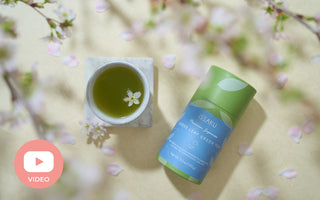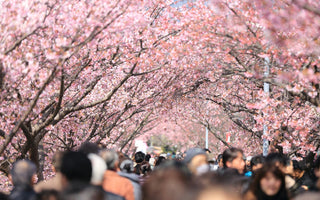As I ponder more on the meditative associations of green tea, a book on the very topic written by a Japanese scholar for a Western audience came to mind. In the simply but aptly titled “The Book of Tea,” Okakura Kakuzo elaborated on the role tea plays in Japanese society.
What does a book detailing the influence of tea on early 1900 Japanese culture have to do with our daily green tea consumption in these more modern times? As we sip green tea in the comfort of our contemporary home, in a trendy café, or wherever we happen to partake of the wholesome brew, we know that the choice is a conscious one.
As much as green tea, especially matcha, offers delightful nuances to the palate, the choice to drink green tea usually stems from specific intentions. For example, considering the benefits provided by the brew, the main motive could be weight loss, better health, detox, etc. But what if getting into a green tea habit can do so much more than alter your physical wellbeing for the better? (Learn about green tea’s many health benefits.)
Green tea is undoubtedly known to be soothing. Most kinds of tea are, but green tea affords the drinker a focused sense of calm. It allows relaxation but also concentration at the same time. For this reason, it is often included in meditation rituals. Why should you be interested in meditation? Studies show that it has a slew of wonderful science-based perks, including stress and anxiety reduction, better sleep, improved cognitive skills, and personality improvement. That green tea can play a significant role in this incredibly beneficial practice is explained by a concept Okakura referred to as “teaism.”

What Is Teaism?
Okakura first coined teaism in “The Book of Tea,” the complete title of which is “The Book of Tea: A Japanese Harmony of Art, Culture, and the Simple Life.” The Japanese translation for teaism is “chado,” which also happens to be the term used for the Japanese tea ceremony. It literally means “the way of the tea.” It places tea in a lofty position and identifies it not as a mere beverage but as a promoter of the gentle arts of peace. (Read about the tea ceremony as a form of therapy. Or Watch What is Tea Ceremony video we created)
As commonly known, green tea has a close association with certain persuasions, particularly Taoism and Zen Buddhism. This is why it is a ubiquitous presence in many meditation rituals, particularly the tea ceremony, which was initiated by Japanese Zen monks. Nonetheless, according to the book, teaism also emphasizes tea’s role in secular Japanese life. This means that even outside the religious realms, tea still has the power to teach all sorts of virtuous ideals. The tea ceremony has gone beyond the limits of religion to extend to the very culture that shaped the conduct of Japanese people. (Read further about tea and meditation.)
To support Okakura’s point about teaism, there is another concept called tea mind, a certain sense of concentration and focus achieved under the influence of a cup of tea. As emphasized, tea partners really well with mindfulness exercises. Teaism and tea mind both delineate the meditative qualities of tea, thanks to certain chemicals (theanine, or L-theanine) that allow a person to relax and slow down to better appreciate the little details of life.
In relation to this idea, Okakura discussed the Japanese expression “too little tea,” which is used to refer to somebody who’s too busy to stop and smell the roses, so to speak. Teaism urges you to pay attention to the beauty and importance of little things, which actually make up what is truly essential in life. Okakura showed how the existence of such an idiom gives further value to the role of tea in the Japanese ideals of a good, mindful life. (Find out the different chemical components of green tea.)
In effect, the Japanese regard for tea as more than a drink and their practice of chado result in a mindset that allows them to foster accord among people, promote harmony with the natural world, calm the heart, discipline the mind, and achieve enlightenment or a deeper understanding of things. This is what teaism in practice looks like.

How Does Teaism Influence Behavior?
Meditation is integral to the tea ceremony, but how did it become integral to the culture? Of course, it cannot be denied that the Japanese are known for their calm behavior. But how exactly do the tenets of the chado or teaism translate to other aspects of their lives?
Okakura proposed that the rituals involved in the tea ceremony can be applied to virtually any activity, giving seemingly trivial tasks endless meaning. In the same way that you patiently wait for your water to boil, noticing the wisps of steam that escape, appreciating the various implements you use, and experiencing various sensations evoked by the process, you can also carry out other tasks in the same spirit.
To illustrate the impact of teaism on banal activities, imagine flower arranging done in the same meditative approach as the tea ceremony. When you arrange flowers, you can notice each stem, mind the spaces you place between them, take the time to feel thankful for the blooms, and concentrate on their beauty. There’s a sensitivity to the small details, a conscious liking for the objects involved, an avoidance of hurry or complication, and an absolute commitment to every single moment.
Watch video about mindfulness where we explorer teaching from Sen No Rikyu here
When I started meditating, I wondered about this devotion to the present and the seeming disregard for the future. As my understanding grew and deepened, I realized that being devoted to the “now” actually gives me a better sense of eternity since every moment in the present is part of eternity. It is already real and not imagined, unlike the future; nobody really knows what may happen or not.
The brushing of my teeth, the drive I make to get to work… even in the middle of doing them, they already become part of forever. It’s not that these actions are special; it’s the approach we take in doing them that makes them so. This is what meditation helps us realize, and this is how teaism spread to the ordinary aspects of daily life and affected general mindset and behavior.
Who is Okakura Kakuzo?
“The Book of Tea” identifies teaism as a romantic aesthetic that tenderly attempts to achieve the impossibilities of life. It goes against man’s propensity toward mindless and unintentional living. With Japan’s attention to detail and precision, it seems incongruous that teaism is essentially a worship of the imperfect, but that’s what it is, according to Okakura Kakuzo. Teaism encourages us to find beauty and magic in the sordid details of trivialities. Does that make sense? What do we know about this writer?
Also known as Okakura Tenshin, he was a Japanese art critic and scholar who defended traditional beliefs and customs during the Meiji Restoration reform. He is most known for writing “The Book of Tea,” which he did so in English following the conclusion of the Russo-Japanese War. He wrote it for the purpose of educating Westerners who tended to look down on the tea ceremony as nothing more than another one of the East’s barbarous and childish oddities. His explanation worked to dispel their wrong notions.
In the book, he also reminded his readers that tea was instrumental in opening doors between the East and the West and that, as a commodity, it was influential enough to spark the American Revolution. So there certainly seems to be more power to tea than what people tend to expect.
The Book of Tea in Today’s World
Okakura’s "The Book of Tea" has since become a classic. In fact, its classic edition is available now with a lovely hardcover slipcase that would make it a graceful and elegant addition to any collector’s bookcase or tea lover’s coffee table.
“The Book of Tea” isn’t merely a quaint title from a forgotten time. It’s not just worthwhile reading with sufficient literary merit, although Okakura did display a flair for both poetic and philosophical discourse. To date, it helps people enhance their enjoyment of the brew and understand how a simple drink can shape an entire culture, influencing everything from cuisine and art to philosophy and behavior.
That tea-oriented behavior is something that speaks to a wide range of audiences today. In teaism, the person is urged toward an alternative perspective for greater appreciation of the mundane and reminded of certain truths that really simplify life to make it more enjoyable. In this fast-paced life wherein many suffer from the strains of modern living, a bit of the focused calm that tea can deliver certainly holds more than a little appeal, especially since it goes a long way toward generating feelings and habits of gratitude and positivity.
Get Free Bonus Books





